Panasonic CF-20 operating instructions
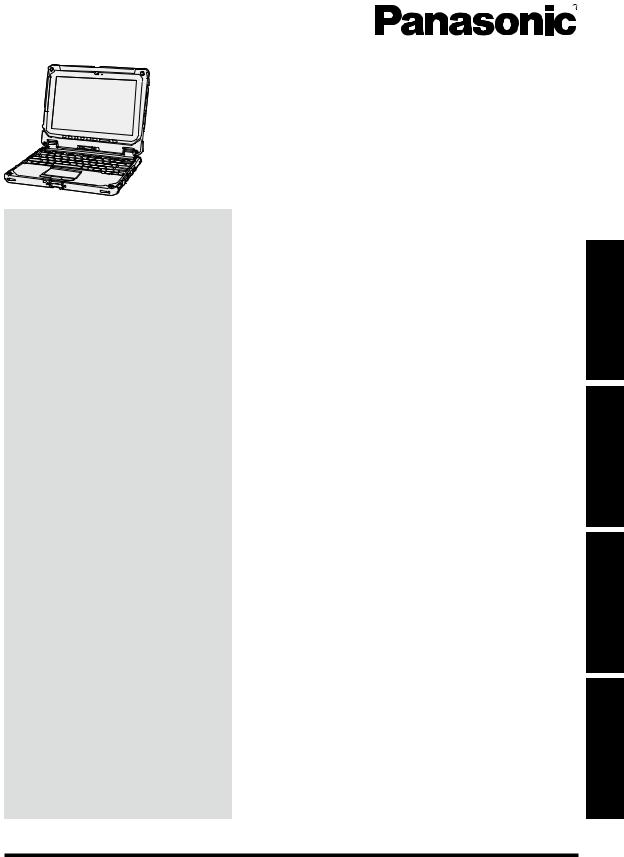
OPERATING INSTRUCTIONS
Basic Guide
Personal Computer |
||
|
CF-20 |
|
Model No. |
|
series |
Contents |
|
|
Getting Started |
|
|
Introduction..................................................... |
|
2 |
Description of Parts......................................... |
|
4 |
First-time Operation..................................... |
|
14 |
Turning On / Turning Off............................... |
|
20 |
Useful Information |
|
|
Handling and Maintenance.......................... |
|
21 |
Installing Software........................................ |
|
26 |
Troubleshooting |
|
Troubleshooting (Basic)............................... |
31 |
Appendix |
|
LIMITED USE LICENSE AGREEMENT....... |
36 |
Specifications............................................... |
40 |
LIMITED WARRANTY.................................. |
45 |
Standard Limited Warranty.......................... |
52 |
Troubleshooting Useful Information Getting Started
Appendix
Please read these instructions carefully before using this product, and save this manual for future use.
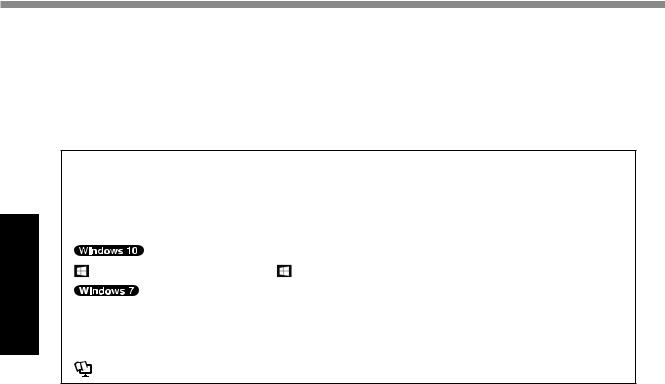
Getting Started
Introduction
Thank you for purchasing this Panasonic product. For optimum performance and safety, please read these instructions carefully.
In these instructions, the names are referred as follows.
 indicates Windows 10 Operating System.
indicates Windows 10 Operating System.  indicates Windows 7 Operating System.
indicates Windows 7 Operating System.
n Terms and illustrations in these instructions
|
|
|
|
|
|
: |
Conditions that may result in minor or moderate injury. |
CAUTION |
|||||||
|
|
|
|
: |
Useful and helpful information. |
||
NOTE |
|||||||
|
|
|
: |
|
Press [Enter] key. |
||
Enter |
|||||||
|
+ |
|
: |
Press and hold [Fn] key, and then press [F5] key. |
|||
Fn |
F5 |
||||||
- [All Apps] : |
Click (Start) and then click [All Apps]. |
||||||
 (Start) - [All Programs] : Click
(Start) - [All Programs] : Click  (Start), and then click [All Programs]. You may need to
(Start), and then click [All Programs]. You may need to
|
double-click in some cases. |
è : |
Page in these Operating Instructions or in the Reference Manual. |
: |
Reference to the on-screen manuals. |
•Some illustrations are simplified to help your understanding and may look different from the actual unit. Some types of software are automatically updated, and differences may occur from descriptions in this manual.
•If you do not log on as an administrator, you cannot use some functions or cannot display some screens.
•Refer for the latest information about optional products to the catalogs, etc.
•In these instructions, the names and terms are referred as follows.
“Windows 10 Pro 64-bit” as “Windows” or “Windows 10”
“Windows 7 Professional 32-bit Service Pack 1” and “Windows 7 Professional 64-bit Service Pack 1” as “Windows” or “Windows 7”
DVD MULTI drive as “CD/DVD drive”
Circular media including DVD-ROM and CD-ROM as “discs”
“Multilanguage User Interface” as “MUI”
The Digitizer + Touch Screen (Capacitive) as the “digitizer”, and the Touch Screen as the “touchscreen”.
The digitizer pen and the stylus as the “pen (included)”.
“Operating Instructions Reference Manual” and “Operating Instructions Connect to a network” as the “Reference Manual” and “Connect to a network”.
•
Screen messages are explained in [English (United States)].
(Depending on the language preference, some screen messages in these instructions are different from the actual screen messages. For example, [Flight mode] may be displayed instead of [Airplane mode] in some language preference.)
n Disclaimer
Computer specifications and manuals are subject to change without notice. Panasonic Corporation assumes no liability for damage incurred directly or indirectly from errors, omissions or discrepancies between the computer and the manuals.
2
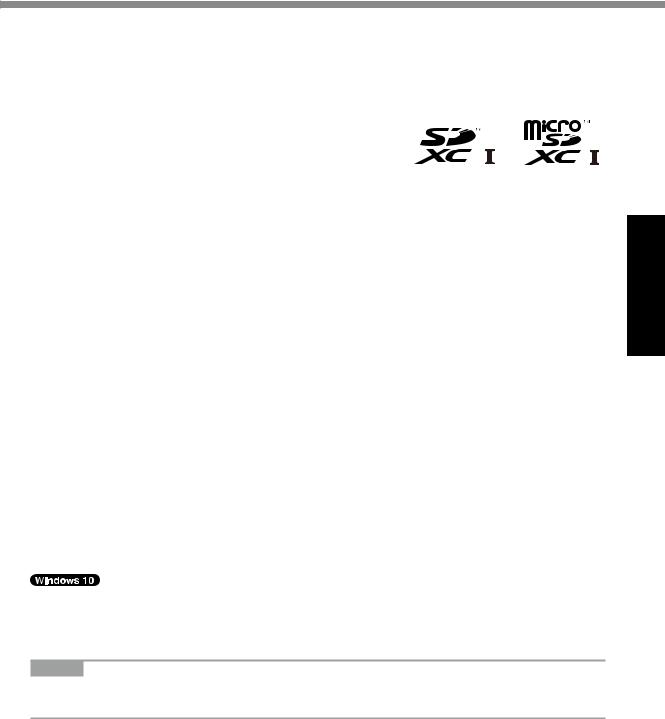
n Trademarks
Microsoft®, Windows®, the Windows logo, and IntelliMouse are registered trademarks of Microsoft Corporation of the United States and/or other countries.
Intel, Core and PROSet are either registered trademarks or trademarks of Intel Corporation.
SDXC and microSDXC Logos are trademarks of SD-3C, LLC. |
|
Adobe, the Adobe logo and Adobe Reader are either registered trademarks or trademarks of Adobe Systems Incorporated in the United States and/or other countries.
Bluetooth® is a registered trademark owned by Bluetooth SIG, Inc., U.S.A. and licensed to Panasonic Corporation.
HDMI, the HDMI Logo and High-Definition Multimedia Interface are trademarks or registered trademarks of HDMI Licensing LLC in the United States and other countries.
Names of products, brands, etc., appearing in this manual are trademarks or registered trademarks of their respective own companies.
n On-screen Manual
For further information about the computer, you can refer to the on-screen manual.
lOperating Instructions - Reference Manual
This Manual contains the practical information to help you fully enjoy the computer’s performance. Update it to the latest version for reference.
lImportant Battery Tips
The Important Battery Tips will provide you with the battery information so that you can use the battery in the optimum condition to obtain longer operation time.
lUpdate the on-screen manuals
This describes the procedures to update the on-screen manual.
lOperating Instructions - Connect to a network
This describes the connection procedures using the network devices mounted on this unit.
To access the on-screen manuals, follow the steps below.
Double-click [Manual Selector] on the desktop, and select the manual and click [Open].
1.Double-click the [Panasonic PC Settings Utility] on the desktop screen, and then click [Support] - [Manual] - [Launch Manual Selector].
2.Select the manual and click [Open].
NOTE
[Contents] tab or [Search] tab of the on-screen manuals is displayed on the left side of the window. Select tab and display the desired item.
Getting Started
3
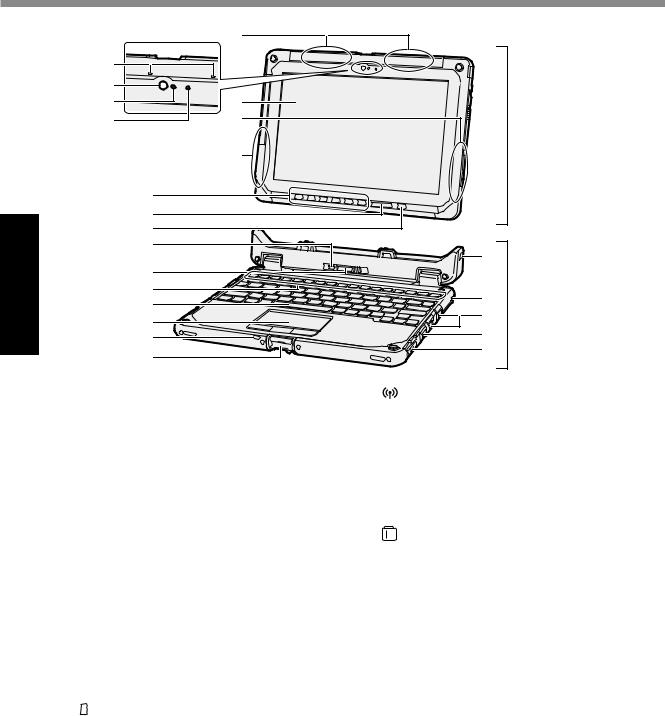
Description of Parts
Getting Started
Camera |
A |
|
|
B |
|
|
|
C |
|
|
|
D |
F |
|
|
E |
G |
Main Unit |
|
|
|
||
|
H |
|
|
I |
|
|
|
J |
|
|
|
K |
|
|
|
L |
R |
|
|
M |
|
||
|
|
||
N |
S |
|
|
O |
Keyboard Base |
||
T |
|||
P |
|
||
U |
|
||
J |
|
||
Q |
V |
|
|
|
|
A:Wireless WAN Antenna / GPS Antenna
<Only for model with wireless WAN/GPS>
è Reference Manual “Wireless WAN”
Reference Manual “Wireless WAN”
è Reference Manual “GPS”
Reference Manual “GPS”
B:Microphone
C:Camera Lens
D:Ambient Sensor
E:Camera Indicator
è Reference Manual “Camera”
Reference Manual “Camera”
F:LCD
G:Wireless LAN Antenna / Bluetooth Antenna
H:Wireless LAN Antenna
è Reference Manual “Bluetooth” Connect to a network “Wireless LAN”
Reference Manual “Bluetooth” Connect to a network “Wireless LAN”
I:Tablet Buttons
è Reference Manual “Tablet Buttons”
Reference Manual “Tablet Buttons”
J:LED Indicator
 : Battery Status
: Battery Status
 : Power Status
: Power Status
Off: Power off/Hibernation Green: Power on Blinking Green: Sleep Blinking green rapidly:
Cannot power on or resume due to low temperature.
:Wireless ready
This indicator lights when Wireless LAN, Bluetooth, and/or Wireless WAN are connected and ready. It does not necessarily indicate the On/Off condition of the wireless connection.
è  Connect to a network
Connect to a network
 : Caps Lock indicator
: Caps Lock indicator
 : NumLk (numeric lock) indicator
: NumLk (numeric lock) indicator 
 : ScrLk (scroll lock) indicator
: ScrLk (scroll lock) indicator
K:Power Switch
L:Detach Lock
M:Release Lever
N:Function (Fn) Keys
è Reference Manual “Function Keys”
Reference Manual “Function Keys”
O:Keyboard
P:Touchpad
è Reference Manual “Touchpad”
Reference Manual “Touchpad”
Q:Display Latch
R:Security Lock (Clamshell)
When the main unit is connected, both the main unit and keyboard base can be secured at the same time.
S:Security Lock (Keyboard base)
A Kensington cable can be connected. For further information, read the manual that comes with the cable.
4

T:USB 3.0 Port
è Reference Manual “USB Devices”
Reference Manual “USB Devices”
U:LAN Port
è Connect to a network “LAN”
Connect to a network “LAN”
V:Serial Port
è Reference Manual “Serial Port”
Reference Manual “Serial Port”
Getting Started
5
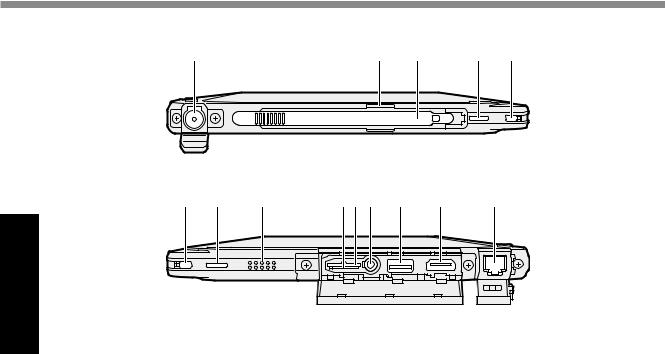
Getting Started
Description of Parts
Main Unit (Right Side)
A B C D E
Main Unit (Left Side)
E |
D |
F |
G H I |
J |
K |
L |
A:DC-IN Jack
Only the main unit can be charged.
B:Pen Holder
C:Pen
D:Tether Hole
E:Security Lock (Main Unit)
A Kensington cable can be connected. For further information, read the manual that comes with the cable.
F:Speaker
The speaker contains a magnet and magnetic products. Avoid leaving metallic object or magnetic media in contact with these areas.
G:SD Memory Card Indicator
(Blinking: During access or a password is requested)
H:microSD Memory Card Slot
Keep microSD Memory Cards away from infants and small children.
è Reference Manual “SD Memory Card”
Reference Manual “SD Memory Card”
I:Headset Jack
A headset or headphone can be connected.
J:USB 3.0 Port (CHG)
Do not insert any foreign object in the USB port.
è Reference Manual “USB Devices”
Reference Manual “USB Devices”
K:HDMI Port
è Reference Manual “External Display”
Reference Manual “External Display”
L:LAN Port
è Connect to a network “LAN”
Connect to a network “LAN”
6
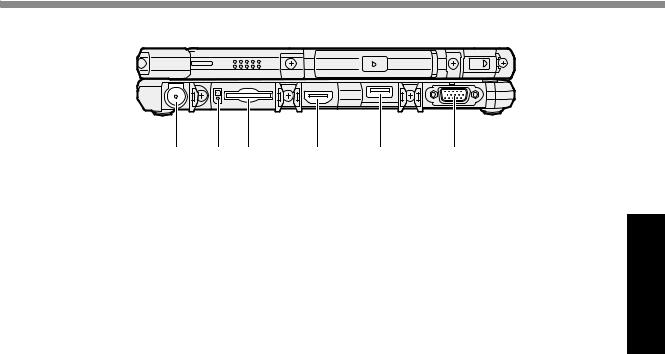
Keyboard Base (Left Side)
A |
B |
C |
D |
E |
F |
A:DC-IN Jack
B:SD Memory Card Indicator
(Blinking: During access or a password is requested)
C:SD Memory Card Slot
Keep SD Memory Cards away from infants and small children.
è Reference Manual “SD Memory Card”
Reference Manual “SD Memory Card”
D:HDMI Port
è Reference Manual “External Display”
Reference Manual “External Display”
E:USB 2.0 Port
è Connect to a network “USB Devices”
Connect to a network “USB Devices”
F:VGA Port
è Reference Manual “External Display”
Reference Manual “External Display”
Getting Started
7
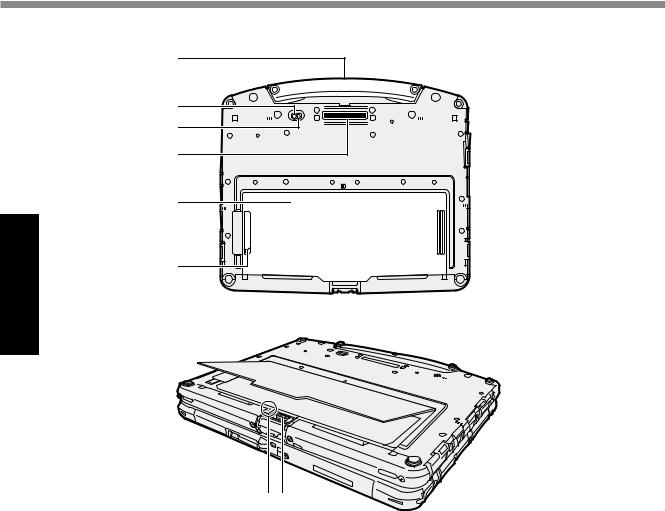
Getting Started
Description of Parts
Keyboard Base (Bottom Side)
A
B
C
D
E
F
G H
A:Carrying Handle
B:External Antenna Connector (CH2)
C:External Antenna Connector (CH1)
D:Expansion Bus Connector
è Reference Manual “Port replicator”
Reference Manual “Port replicator”
E:Battery Cover
F:Battery Cover Latch
G:LED Indicator
 : Battery Status
: Battery Status
è Reference Manual “Battery Power”
Reference Manual “Battery Power”
H:Battery Pack Latch
è Reference Manual “Battery Power”
Reference Manual “Battery Power”
8
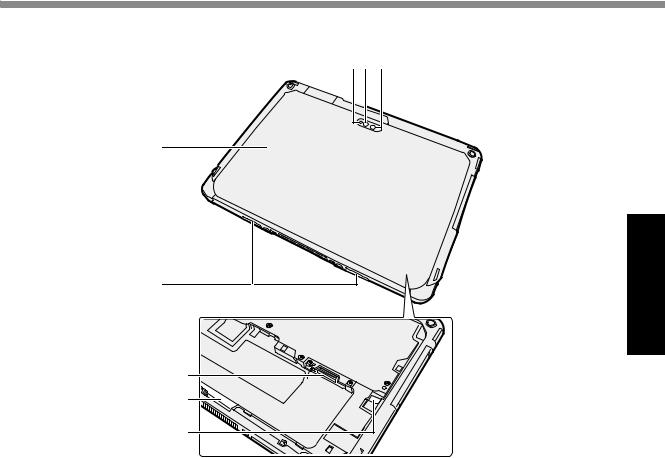
Main Unit (Bottom Side)
A B C
D
E
F
G
H
Rear Camera
<Only for model with Rear Camera>
A:Camera Indicator
B:Camera Light
C:Camera Lens
è Reference Manual “Camera”
Reference Manual “Camera”
D:Back Cover
The shape of this may vary depending on the model.
E:Release Latch
F:microSIM Card Slot
<Only for model with wireless WAN>
è Connect to a network “Wireless WAN”
Connect to a network “Wireless WAN”
G:Battery Pack Latch
è Reference Manual “Battery Power”
Reference Manual “Battery Power”
H:LED Indicator
<Only for model with built-in bridge battery>
 : Battery Status
: Battery Status
è Reference Manual “Battery Power”
Reference Manual “Battery Power”
Getting Started
9
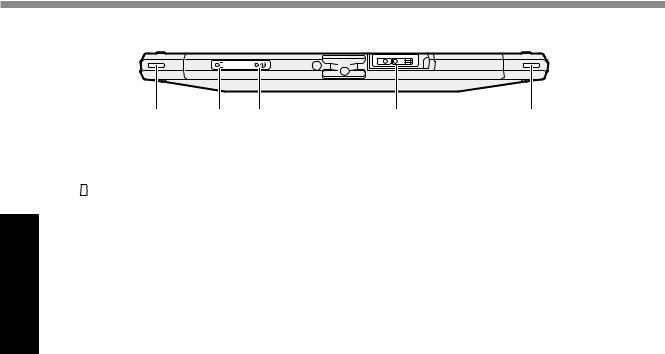
Description of Parts
Main Unit (Top Side)
Getting Started
A B B C A
A:Tether Hole
B:LED Indicator
 : Battery Status
: Battery Status
 : Power Status
: Power Status
Off: Power off/Hibernation Green: Power on Blinking Green: Sleep Blinking green rapidly:
Cannot power on or resume due to low temperature.
C:Barcode Reader
<Only for model with Barcode Reader>
è Reference Manual “Barcode Reader”
Reference Manual “Barcode Reader”
10

Detaching the main unit from the keyboard base
After Detach the main unit from the keyboard base, you can use the main unit as a tablet or reattach it in the reverse direction.
CAUTION
•Before detaching the main unit, confirm the following things.
--Save the necessary data.
--Close files you have opened from removable disks and network drives.
--Remove peripheral devices connecting to the main unit.
•Do not detach the main unit in the conditions below.
•When the SD Memory Card indicator is on.
•When playing/recording audio files or displaying motion video such as MPEG files.
•When playing a DVD-Video.
•When writing to a disc.
•When using communication software or network functions.
A To detach the main unit while it is turned on, perform the following.
CAUTION
zzBefore detaching the main unit, check the remaining battery power by pressing the Fn and
F9 keyboard keys at the same time.
When the battery status of the “Battery 1” becomes 5% or less, can not detach the main unit from the keyboard base.
Windows 10 |
|
|
Click |
in the taskbar of the desktop screen, and then click |
- [Eject Keyboard Base |
Device]. |
|
|
Click  in the notification area, and then click
in the notification area, and then click  - [Eject Keyboard Base Device]. “Undock Complete” appears at the bottom right of the screen.
- [Eject Keyboard Base Device]. “Undock Complete” appears at the bottom right of the screen.
NOTE
zzA confirmation message may appear if an SD memory card is inserted in the keyboard base. If “Undock Complete” appears, click [OK] in the confirmation message, and proceed to step B.
The same operation can be performed by pressing the Fn and 1 keyboard keys at the same time.
NOTE
zzTo cancel detachment, press the Fn and 1 keyboard keys at the same time after the above operation
B Release the detach lock (A).
Getting Started
11

Getting Started
Description of Parts
C Slide the release lever (B) in the direction of the arrow.
2 3
RELEASE






A B
D Detach the main unit from the keyboard base.
CAUTION
• When detaching the main unit from the keyboard base, hold the position at the locations dashed line circled in the illustration.
The main unit can be attached facing the reverse direction.
CAUTION
•Depending on the shape of the main unit’s rear, you may not be able to operate the unit with the main unit attached in the direction illustrated. Be sure to verify this before actual use.
NOTE
• Do not attach/detach the main unit in the rain.
12
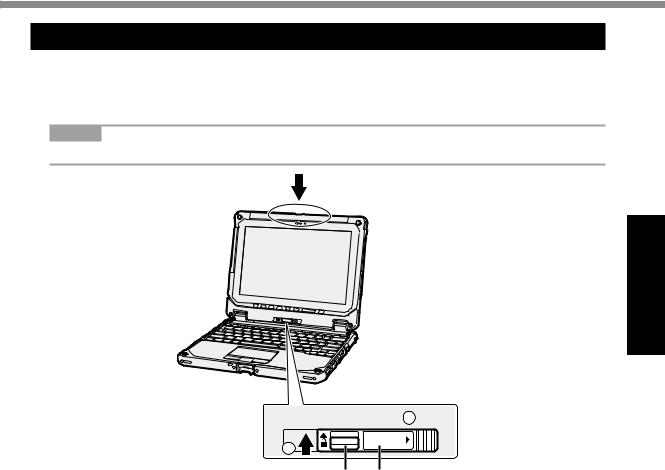
Attaching the main unit to the keyboard base
APush the main unit at the locations dashed line circled in the illustration in a downward direction.
Release lever (B) will return to the direction of the arrow.
BRaise detach the lock (A) above.
NOTE
zzConfirm that the red signs near the detach lock and the release lever can not be seen.
Getting Started
 1
1
2 |
RELEASE |
|
A B
13
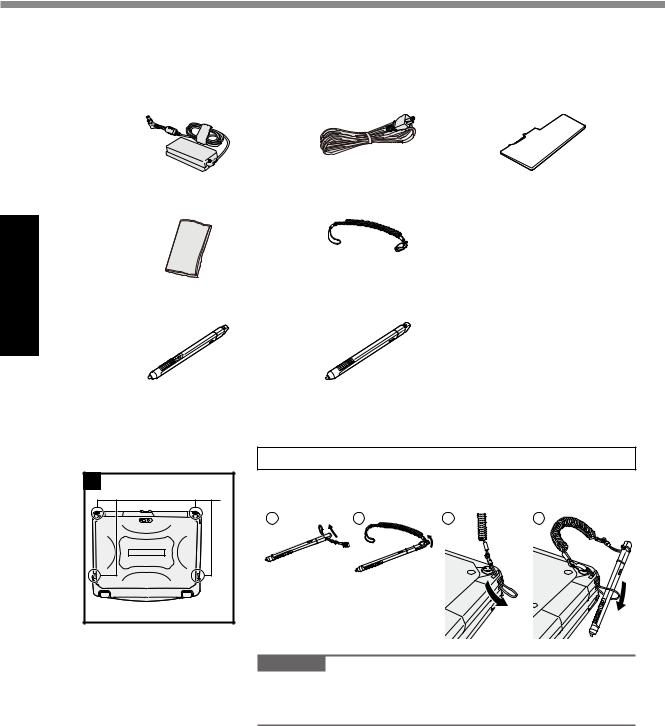
First-time Operation
nPreparation
ACheck and identify the supplied accessories.
If you do not find the described accessories, contact your support office.
• AC Adaptor. . |
1 |
• AC Cord. . . . 1 |
• Battery Pack . . 1*1 |
|
|
|
|
|
|
Getting Started
Model No: CF-AA6413C |
Model No: CF-VZSU0QW |
• Soft Cloth. . . . 1 |
• Tether. . . . . 1 |
<Only for model with digitizer> |
<Only for model with touchscreen> |
• Digitizer pen. . 1 |
• Stylus. . . . . 1 |
• OPERATING INSTRUCTIONS - Read Me First . . . . . . . . . . . . . 1
*1 Stored in the main unit at the time of packing.
1 |
A |
1 Attaching the pen (included) to the computer
Use the tether to attach the pen (included) to the computer so you will not lose it. There are holes (A) to attach it.
1 |
2 |
3 |
4 |
CAUTION
•Do not pull the tether with excessive force. The stylus may hit the computer, person’s body or other objects when released.
14
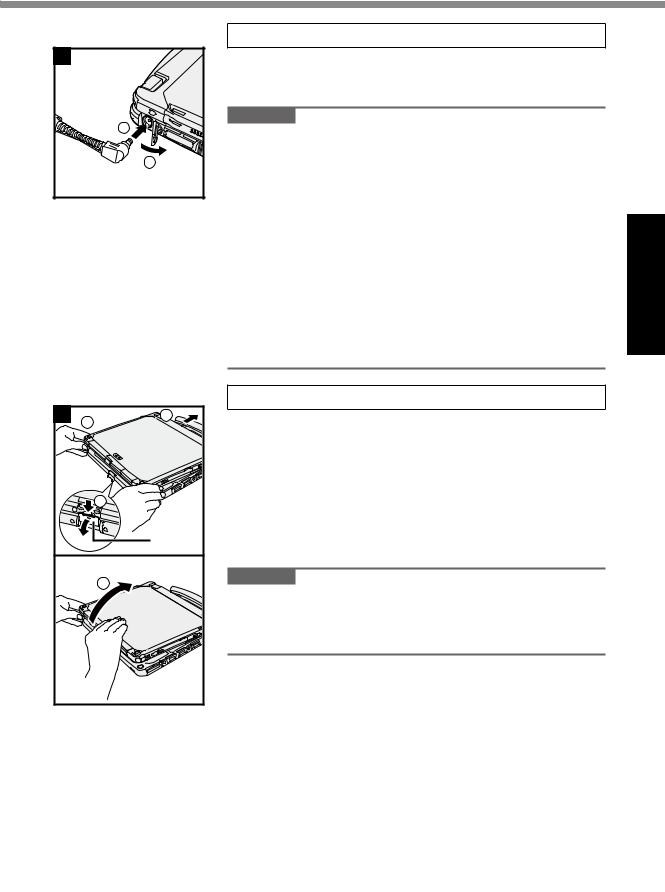
2 |
2 |
1 |
2 Connect your computer to a power outlet
AOpen the cover.
BConnect your computer to a power outlet. The battery charging starts automatically.
CAUTION
•Do not disconnect the AC adaptor until the first-time operation procedure is completed.
•When using the computer for the first time, do not connect any peripheral device except the battery pack and AC adaptor.
•Handling the AC adaptor
Problems such as sudden voltage drops may arise during periods of thunder and lightning. Since this could adversely affect your computer, an uninterruptible power source (UPS) is highly recommended unless running from the battery pack alone.
•When the DC plug is not connected to the computer, disconnect the AC cord from your electrical outlet. Power is consumed simply by having the AC adaptor plugged into an electrical outlet.
3 |
|
3 |
Open the display |
3 |
1 |
A Pull out the handle. |
|
|
|
||
|
|
|
• If you do not pull out the handle before opening the |
|
|
|
display, the computer may fall over due to the weight |
|
|
|
of the display. |
|
2 |
|
B Push down on the latch (B), and pull it out to release it. |
|
|
C Hold the corners with both hands, and lift the display |
|
|
|
|
slightly. |
|
B |
|
D Hold the side of the computer with either of your hands |
|
|
|
and then lift up the display to open. |
|
|
CAUTION |
|
|
|
• Do not open the display wider than necessary (180° or |
|
|
|
|
more), and do not apply excessive pressure to the LCD. Do |
|
|
|
not open or close the computer holding the edge of the LCD |
|
|
|
segment. |
Getting Started
15
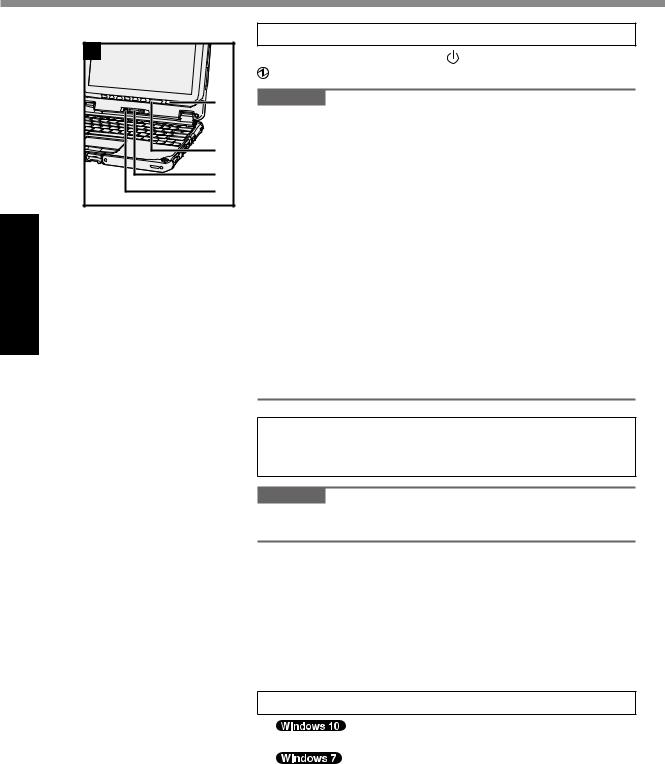
First-time Operation
Getting Started
4 |
4 |
Turn on the computer |
|
|
Press and hold the power switch |
(C) until the power indicator |
|||
|
||||
|
|
(D) lights. |
|
|
C |
CAUTION |
|
||
|
• Do not press the power switch repeatedly. |
|||
|
• The computer will be forcibly turned off if you press and hold |
|||
D |
|
the power switch for four seconds or longer. |
||
• |
Do not perform the following operation until the First-time |
|||
E |
||||
|
Operation is completed. |
|
||
F |
|
• Touching the release lever (E) and detach lock (F) |
||
|
|
• Detaching the main unit from keyboard base |
||
|
|
• Disconnecting the AC adaptor |
||
|
|
• Pressing the power switch |
|
|
|
|
• Closing the display |
|
|
|
|
• Any changes from the default setting of the Setup Utility |
||
|
• Once you turn off the computer, wait for ten seconds or more |
|||
|
|
before you turn on the computer again. |
||
|
• When the CPU temperature is high, the computer may not |
|||
|
|
start up to prevent overheating of the CPU. Wait until the |
||
|
|
computer cools down, and then turn the power on again. If |
||
|
|
the computer does not power on even after cooling down, |
||
|
|
contact Panasonic Technical Support (è pages 45 - 51). |
||
5
<For MUI OS model>
Select language and OS (32-bit or 64-bit)
CAUTION
•Carefully choose your language because you cannot change it later. If you set a wrong language, you need to reinstall Windows.
A Select language and OS (32-bit or 64-bit) on “Select OS” screen and click [OK].
The language setting will start by clicking [OK] on the confirmation screen.
The language and OS setting will be completed in about 15 minutes.
B When termination screen is displayed, click [OK] to turn off the computer.
6 Setup Windows
|
Select language and click [Next]. |
|
Turn on the computer. |
|
Follow the on-screen instructions. |
|
•The computer restarts several times. |
|
•After the computer is turned on, the screen remains black |
|
or unchanged for a while, but this is not a malfunction. Wait |
16 |
for a moment until the Windows setup screen appears. |
|

•During setup of Windows, use the touchpad and clicking to move the pointer and to click an item.
•Setup of Windows will take approximately  5 minutes /
5 minutes /  20 minutes.
20 minutes.
Go to the next step, confirming each message on the display.
•You can set the Wireless Network after the setup of Windows is complete.
 If “Let’s get connected” is displayed, select “Skip this step”.
If “Let’s get connected” is displayed, select “Skip this step”.
“Join a wireless network” screen may not ap-
pear.
• Follow the steps below.
Follow the steps below.
AWhen “Enable sensors” is displayed, click [Enable this sensor].
BWhen the [User Account Control] screen is displayed, click [Yes].
CAt the [Display Rotation Tool] confirmation screen, click
[Yes].
The computer restarts automatically, and the setting is enabled.
CAUTION
•You can change the user name, password, image and security setting after setup of Windows.
•Remember your password. If you forget the password, you cannot use Windows. Creating a password reset disk beforehand is recommended.
•Use standard characters as a computer name: numbers 0 through 9, uppercase and lowercase letters from A to Z, and the hyphen (-) character. If the error message “The computer name is not valid” appears, check if characters other than the above are not entered. If the error message still remains on the display, set the key entry mode to English (“EN”) and enter characters.
•Do not use the following words and characters for user name: CON, PRN, AUX, CLOCK$, NUL, COM1 to COM9,
LPT1 to LPT9, LPT, &, space,  @.
@.
•
In particular, if you create a user name (account name) that includes the “@” mark, a password will be requested at the log-on screen, even if no password has been set. If you try to log on without entering a password, “The user name or password is incorrect.” may be displayed and you will not be able to log on to Windows (è page 33).
Getting Started
17
